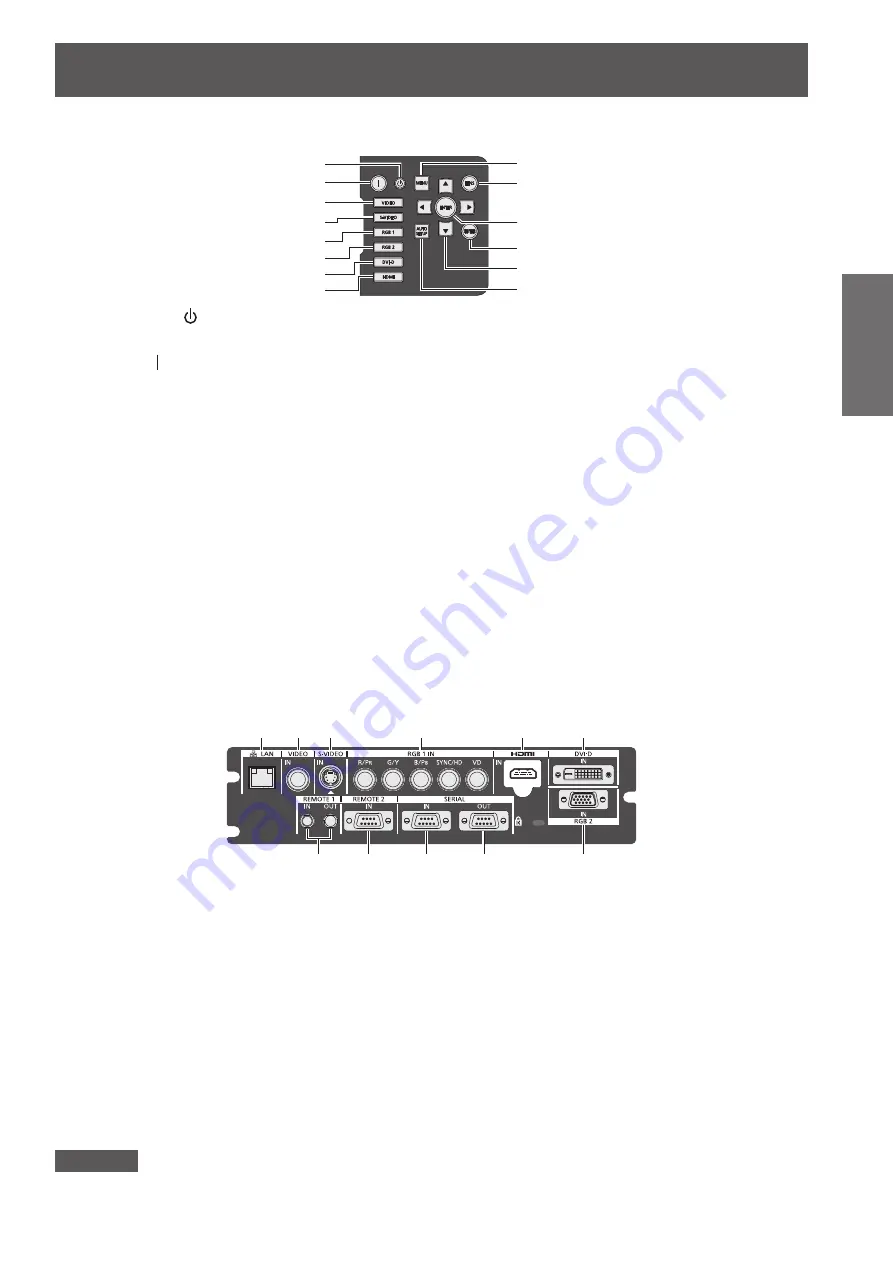
About your projector
ENGLISH - 21
Preparation
▶
■
Control panel
(9)
(10)
(11)
(12)
(13)
(14)
(1)
(2)
(3)
(4)
(5)
(6)
(7)
(8)
(1) Power standby < > button
Sets the projector to the standby mode when the <MAIN
POWER> switch on the projector is set to <ON>.
(2) Power on < > button
Starts projection when the <MAIN POWER> switch on the
projector is set to <ON> when the power is switched off
(standby mode).
(3) <VIDEO> button
Switches to VIDEO input.
(4) <S-VIDEO> button
Switches to S-VIDEO input.
(5) <RGB1> button
Switches to RGB1 input.
(6) <RGB2> button
Switches to RGB2 input.
(7) <DVI-D> button
Switches to DVI-D input.
(8) <HDMI> button
Switches to HDMI input.
(9) <MENU> button
Displays and erases the main menu.
Returns to the previous screen when a sub-menu is
displayed.(
page 44)
If you press the <MENU> button on the control panel for
at least three seconds while the on-screen indication is off,
the on-screen display is turned on.
(10) <LENS> button
Adjusts the focus, zoom, and shift (position) of the lens.
(11) <ENTER> button
Determines and executes an item in the menu screen.
(12) <SHUTTER> button
Use to temporarily turn off the image.(
page 41)
(13)
▲▼◀▶
selection buttons
Use to select items in the menu screen, change settings,
and adjust levels.
It is also used to enter [SECURITY] passwords.
(14) <AUTO SETUP> button
Automatically adjusts the image display position while
projecting the image.
[PROGRESS] is displayed on the screen while the image
is adjusted automatically.(
page 42)
▶
■
Connecting terminals
(1)
(2) (3)
(4)
(5)
(6)
(7)
(8)
(9)
(10)
(11)
(1) <LAN> terminal
This is a terminal to connect to the network.
Used for control and monitoring. Image input through
network connections is not possible.
(2) <VIDEO IN> terminal
This is a terminal to input video signals.
(3) <S-VIDEO IN> terminal
This is a terminal to input S video signals.
(4) <RGB 1 IN> (<R/P
R
>, <G/Y>, <B/P
B
>, <SYNC/HD>,
<VD>) terminal
This is a terminal to input RGB signals or YC
B
C
R
/YP
B
P
R
signals.
(5) <HDMI IN> terminal
This is a terminal to input HDMI signals.
(6) <DVI-D IN> terminal
This is a terminal to input DVI-D signals.
(7) <REMOTE 1 IN> terminal / <REMOTE 1 OUT> terminal
These are the terminals to connect the remote control for
serial control when the system uses multiple projectors.
(8) <REMOTE 2 IN> terminal
This is a terminal to remotely control the projector using
the external control circuit.
(9) <SERIAL IN> terminal
This is a RS-232C compatible terminal to externally control
the projector by connecting a computer.
(10) <SERIAL OUT> terminal
This is a terminal to output the signal connected to the
serial input terminal.
(11) <RGB 2 IN> terminal
This is a terminal to input RGB signals or YC
B
C
R
/YP
B
P
R
signals.
Attention
z
When a LAN cable is directly connected to the projector, the network connection must be made indoors.
















































